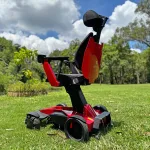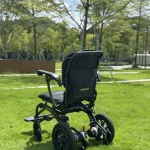Proper maintenance and care of electric wheelchairs are essential to ensure their longevity, performance, and safety. Regular upkeep not only enhances the lifespan of the wheelchair but also helps prevent unexpected breakdowns. This guide outlines key steps and best practices for maintaining your electric wheelchair in top condition.
1. Battery Maintenance
The battery is the heart of an electric wheelchair, so keeping it in good condition is vital:
- Regular Charging: Charge the battery after every use, even if it is not fully depleted.
- Avoid Overcharging: Follow the manufacturer’s guidelines to prevent battery overcharging.
- Storage: Store the wheelchair in a dry environment. Cold temperatures can reduce battery efficiency.
- Replacement: Replace the battery when it no longer holds a full charge or shows signs of damage.
- Check Connections: Regularly inspect battery terminals for corrosion and ensure connections are secure.
2. Tire Care
Tires play a critical role in maneuverability and safety. Proper tire maintenance includes:
- Inspect for Wear and Tear: Check for cracks, punctures, or uneven tread wear.
- Inflate Tires Properly: For air-filled tires, ensure they are inflated to the correct pressure as specified in the manual.
- Solid Tires: If you use solid tires, clean them regularly to remove debris that may affect performance.
- Replace When Needed: Worn-out or damaged tires should be replaced promptly to avoid accidents.
3. Cleaning the Wheelchair
Keeping your wheelchair clean is important for both appearance and functionality:
- Wipe Surfaces: Use a damp cloth with mild detergent to clean the frame, seat, and controls.
- Avoid Excess Water: Do not allow water to enter electronic components or the motor.
- Clean Wheels: Remove dirt, mud, or debris from the wheels regularly.
- Sanitize: Disinfect the joystick, armrests, and other areas frequently touched.
4. Check the Braking System
A reliable braking system is crucial for safety:
- Test Brakes Regularly: Ensure the brakes engage and disengage properly during operation.
- Inspect for Wear: Look for wear on brake pads or any unusual noises when braking.
- Seek Professional Help: If the brakes are not functioning as expected, contact a technician for repairs.
5. Joystick and Control Panel Maintenance
The joystick and control panel are sensitive components that require careful handling:
- Keep Controls Clean: Wipe the joystick and buttons with a soft cloth to remove dust and debris.
- Avoid Liquids: Keep liquids away to prevent damage to the electrical circuits.
- Inspect for Damage: Check for loose connections or signs of wear and tear.
- Calibrate Controls: If the wheelchair does not respond smoothly, have the controls calibrated by a professional.
6. Frame and Upholstery Inspection
The frame and upholstery contribute to comfort and durability:
- Tighten Loose Bolts: Regularly inspect and tighten any loose screws, bolts, or nuts.
- Inspect for Cracks: Check the frame for cracks or structural damage.
- Clean Upholstery: Clean fabric or leather upholstery with appropriate products to prevent wear.
- Repair Tears: Address any rips or damage to the seat or backrest promptly.
7. Motor and Wiring Check
The motor and wiring ensure the wheelchair operates efficiently:
- Listen for Unusual Noises: Unusual sounds from the motor may indicate wear or malfunction.
- Inspect Wiring: Look for frayed wires, loose connections, or corrosion.
- Avoid Overloading: Never exceed the weight capacity, as this puts unnecessary strain on the motor.
- Service Regularly: Schedule professional servicing for motor and electrical components at least once a year.
8. Prevent Rust and Corrosion
Exposure to moisture can lead to rust, which damages the wheelchair:
- Dry After Use: If the wheelchair gets wet, dry it thoroughly to prevent rust.
- Use Protective Covers: Store the wheelchair under a protective cover in damp conditions.
- Inspect Metal Parts: Check for any signs of rust and address them promptly with rust remover or professional servicing.
9. Schedule Professional Inspections
While regular at-home maintenance is important, professional servicing is also necessary:
- Annual Check-Up: Have the wheelchair inspected by a certified technician annually.
- Emergency Repairs: Contact a professional if the wheelchair develops sudden malfunctions or unusual issues.
- Calibration Services: Ensure all controls, motors, and components are properly calibrated.
10. Storage and Transportation
Proper storage and transport ensure your wheelchair stays in great condition:
- Fold Securely: If your wheelchair folds, do so carefully without forcing any parts.
- Safe Storage: Store in a clean, dry environment when not in use.
- Transport Safely: Use proper wheelchair restraints when transporting in a vehicle.
- Protect Components: Remove or cover sensitive electronics during long trips.
Conclusion
Regular maintenance and proper care are essential for keeping your electric wheelchair safe, functional, and reliable. By following these guidelines, you can extend the lifespan of your wheelchair and enjoy uninterrupted mobility. For complex repairs or routine inspections, always consult a certified technician to ensure your wheelchair operates at its best.





















